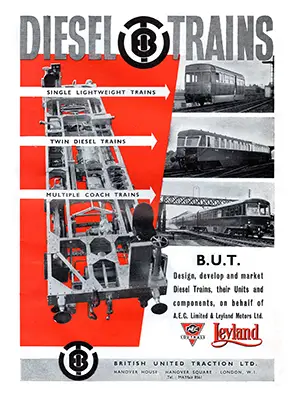ACV / BUT Lightweight Railcars
Description
First Three Vehicles
The bodies were designed by BUT but manufactured for them by Park Royal, and the underframe and mechanics by AEC. Both were ACV companies. As a 3-car set the length was 120ft 9ins over buffers, weighing 39tons 4cwt. The DMT and DMBT each weighed approximately 15 tons, the TT weighed 10tons 10cwt. Maximum speed was 45mph.
They showed an average fuel consumption of 11½ to 12mpg per car, or 5¾ to 6mpg for a 2/3 car set.

The first image shows No. 1, the motor brake third (later 79742). It had two passenger saloons, each seating 16, a cab at each end and a guards / luggage area.

The second image is No.2, the motor third (later 79740). The two saloons were larger holding 24 and 21 passengers, and two part-width cabs.

The third image is No.3, the trailer third (later 79741). Two saloons held 22 / 30 passengers.
Further Eight Vehicles
These were built in two batches, 79743-7 in 1955, as part of a £4m order placed with BUT, mainly for power trains for DMUs, and 79748-50 in 1957.
These eight cars didn't have the bodysides skirts, and had sliding lights rather than droplights on the sides.

Power Train
Each power car was driven by a 125hp AEC engine developing a maximum speed of 1,800rpm and driving through a 4-speed epicyclic gearbox. The reverse gear was incorporated in the double reduction final drive mounted on the axle between wheels and a freewheel was incorporated in the propeller shaft between the engine and gearbox.
The underframe shown in the advert (from February 1954) is believed to be one of the ACV vehicles (No. 1 or 2).

Cabs
The power cars had a cab at both ends, allowing them to be used singly.
Tyres
By August 1956 it was found that the 3-car set in use on the St Albans - Watford line wore out steel tyres at five times the rate of the tyres used on the bogie wheels of DMUs. There was also damage caused to the more delicate parts of the motor by the hammering at rail joints. Trials with pneumatic tyres were abandoned, due to the tremendous wear on the rubber tyres.
Interior
Seats were provided for 129 passengers in the original three cars, as the plans on this page show. The newer vehicles would carry 110 passengers in a 3-car set, and there was considerable standing room. In these one power car had seats for 34, the second just 28 but included a separate luggage comp. The trailer car had accommodation for 48 passengers. A combustion heater was fitted in each car providing warm air through outlet grilles at each seat position.
The seats were bus-type and upholstered in a strawberry pink moquette on at least the first 3-car set. A single passenger access door was provided either side in the centre of the body.
Modifications
By November 1957 the exhaust pipes had been modified, now being discharged at roof rather than rail level, and it was unknown for comments to state that the piping - brought up vertically on one side of the central windscreen - created a very ugly effect.
Liveries
The first three-car set was painted two-tone grey (mid lower, light upper) with red lining, and red buffer beams.
When taken into BR ownership, and in preparation for it taking over the Watford - St Albans branch, it was painted green with cream lining, this being done by April 1955 (see photograph in "Trains Illustrated" for October 1955, page 406). They retained their grey roofs for a period.
All the remaining cars were delivered in lined green with light grey underframe.
Summary
Description
Numbering
Operations
Images
No vehicles were preserved.


